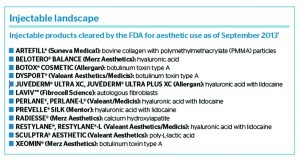Dermal fillers and neurotoxins have evolved into the ideal gateway to aesthetic medicine. Injectables are taking centre stage in aesthetic practices in new and emerging ways, and the rate of satisfaction among patients is consistently high. Once upon a time, fillers were just for filling in lines and scars, and plumping lips. The realities of modern practice have transformed this category from being thought of as simply adjuncts to surgical enhancements to highly effective treatments using complex techniques that warrant skill and expertise.
A global slowdown in innovation has created a void in the filler market that has paved the way for practitioners to step up their game in terms of experimenting with advanced techniques, new instrumentation, and unique combinations and layering of products. Fillers containing lidocaine for pain management have become the gold standard. Emphasis on pain-free injections using soft or bendable needles, tubes, blunt-tip cannulas, injector pens, and novel systems that are touted to cause less trauma and bruising are revolutionising the way fillers are being injected. Practitioners are combining fillers in the same syringe, in addition to the same facial region. Another technique often used is to dilute fillers to make them more appropriate for injecting into fine lines.
Fillers are not one size fits all
‘I have seen the filler market change dramatically over the last 17 years. There was a time when all we had were the line fillers: bovine collagen and autologous fat. Those of us pioneering injection techniques and pan-‑facial augmentation with fat back then were thought to be radical. I remember going to a lecture by a well-known cosmetic dermatologist in the early 90s who emphatically said ‘fillers fill and lifts lift so don’t confuse the two’. Now a decade and a half later everyone is using fillers to lift, blend, and smooth. It’s really amazing when you think about how this area has evolved,’ says New Haven, CT, Dermatologist Lisa M. Donofrio, MD.
Indeed, injectables are useful alternatives as well as adjuncts to surgical procedures, and are widely considered a mainstay in aesthetic practices. They can prevent wrinkles in younger patients, reduce fine lines, and smooth scars in patients in their 30s, and reverse deeper wrinkles in patients in their 40s and older. Fillers are also valuable tools for reshaping the face, adding fullness, enhancing contours, correcting asymmetries, smoothing out bony irregularities, and solving issues of facial ageing that surgery does not address effectively. They are also used to correct minor defects post-surgery. Even for plastic surgeons who would rather be operating, injectables have taken on new relevance in today’s consumer-driven climate.
‘Dermal fillers can enhance the results of a surgical facelift nicely, especially in terms of volumisation. But these treatments are also viewed as an alternative in many cases, such as younger patients who do not have significant sagging, and those who are not good candidates for surgery. Injectables buy time until the patient is physically, mentally, and financially ready for a surgical procedure,’ says New York City Plastic Surgeon Alan Matarasso, MD, FACS.
‘Today’s injectable patient may be tomorrow’s surgical patient, if their expectations are managed so they understand when surgery is indicated,’ he continues.

Far from a ‘one size fits all’ type of treatment, dermal fillers command skill to create an optimal result. Advanced non-surgical techniques for facial rejuvenation involve looking at the face in a three dimensional way and using a robust combination of facial-shaping agents.
Knifeless facelifts
Who gets injected with what and where depends largely on the patient’s desires, budget, and understanding of their ageing process. High volume injectors do not treat every patient in the same way. They tend to graduate to using more volume to address multiple areas of the face in one session, which has elevated filler treatments to an unprecedented level.
As recently as a decade ago, patients that presented with sagging in the midface and jowls would have been told that they needed a surgical face and necklift under general anaesthesia, and 2 weeks out of work for recovery. They would most likely have been turned away from any non‑surgical or minimally-invasive treatments. Today, by using advanced facial contouring techniques, practitioners are able to produce facelift-like results to meet consumers’ demands for safe, effective and long‑lasting non-surgical options.
Products that stimulate the production of new collagen, thereby increasing volume and correction over time, have had a dramatic impact on facial contouring. Unlike hyaluronic acid gels, which offer immediate results, these substances are designed to gradually cause a foreign body reaction to achieve long‑lasting effects. According to New York City Plastic Surgeon Bryan G. Forley, ‘Products that are biostimulatory like Sculptra® Aesthetic enhance new collagen production to produce longer-lasting volumetric correction. When combined with skin tightening devices, we can achieve dramatic effects that approximate what a facelift can do in some instances. We now have a range of fillers that are useful to fill an isolated wrinkle, as well as fillers that can be injected into multiple tissue planes to create a change in facial shape and restore volume.’
Radiesse® is another popular choice for facial contouring and volumetric lifting owing to its ability to create structural collagen support. ‘Radiesse is a wonderful volume filler. It can correct the hollows that develop in the cheeks, recreate flattened cheekbones, and make the jowls look smoother. Its excellent longevity, versatility, and lifting capacity make it my go-to filler for facial contouring,’ says New York City Dermatologist Judith Hellman, MD.
When you consider that a typical ‘Liquid Facelift’ takes about 30 to 60 minutes and patients can wear make-up almost immediately and resume normal activities within 1 to 3 days, this represents a quantum leap over the ‘wind tunnel’ facelift that was prevalent in the 80s.



